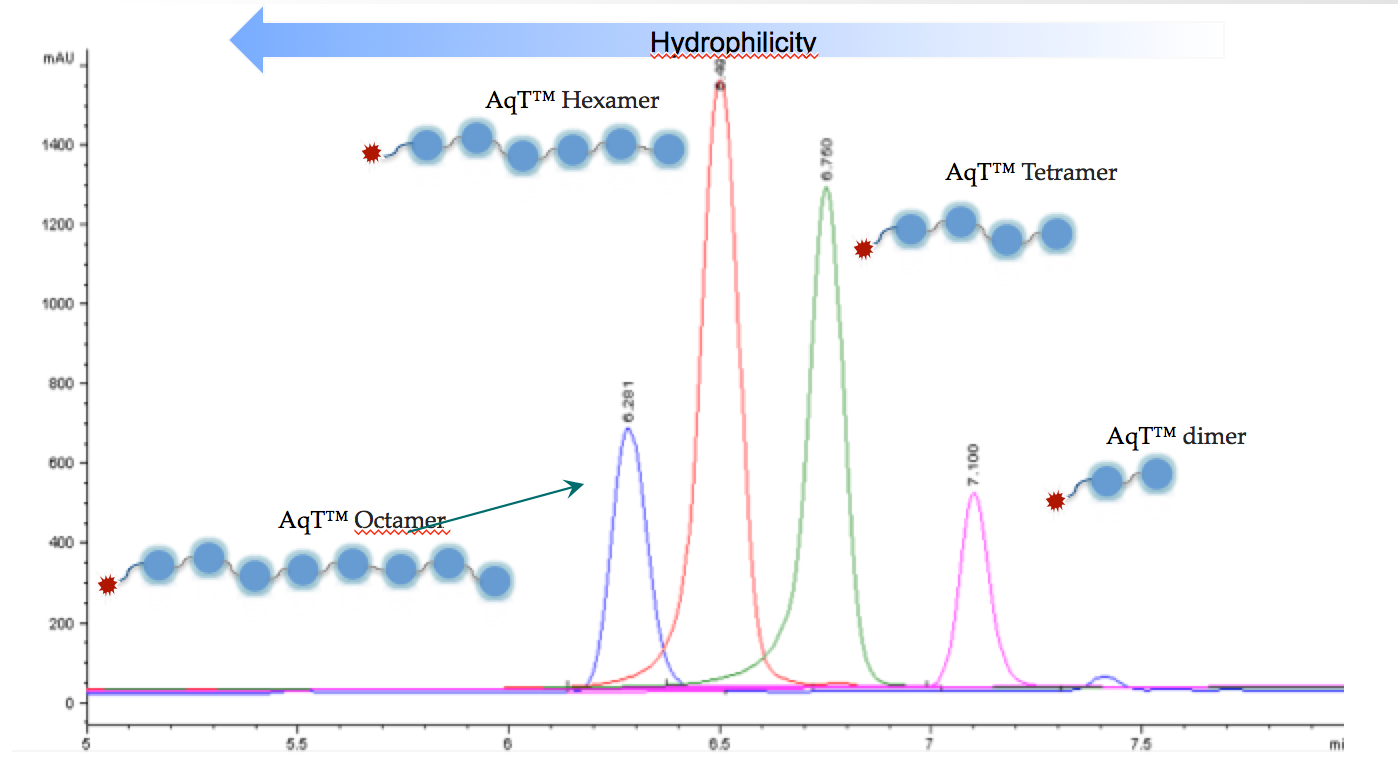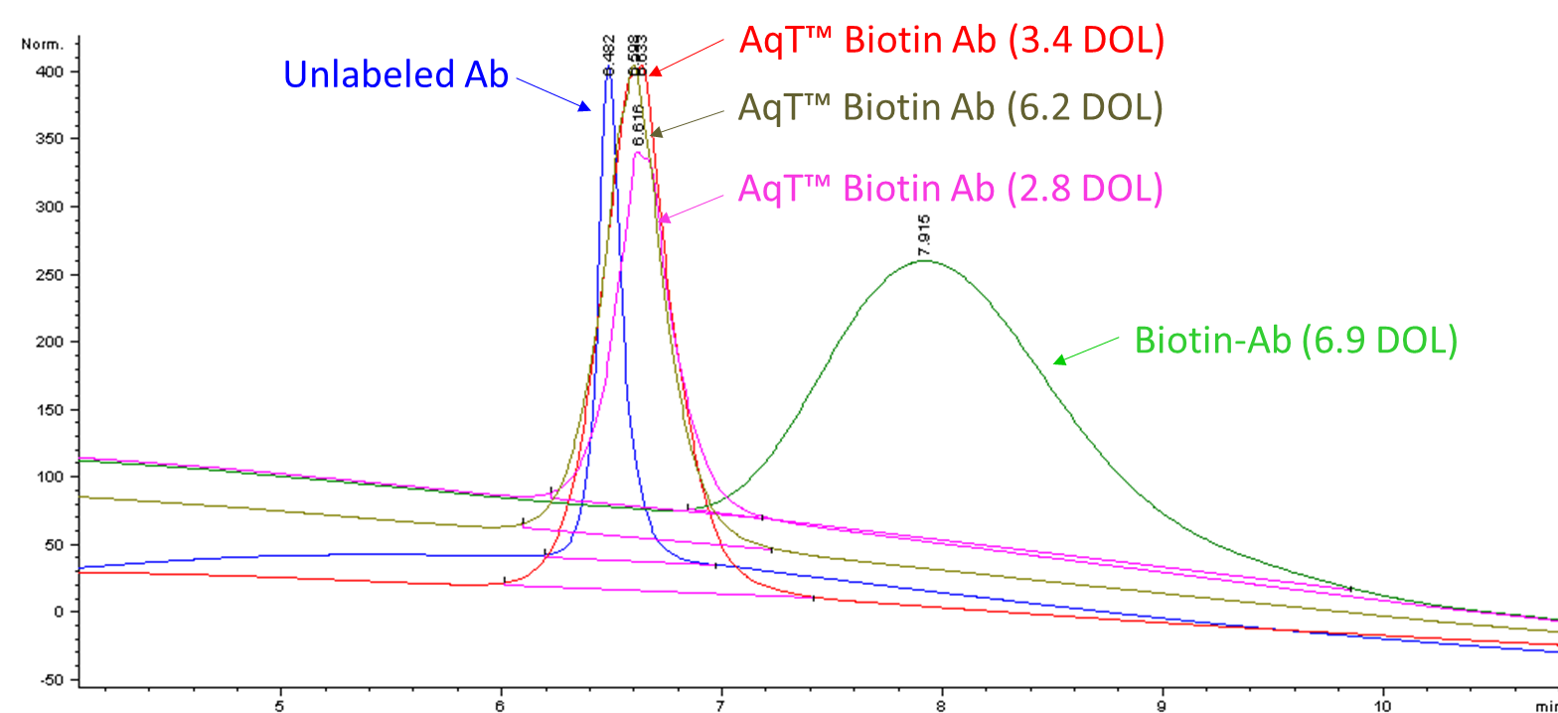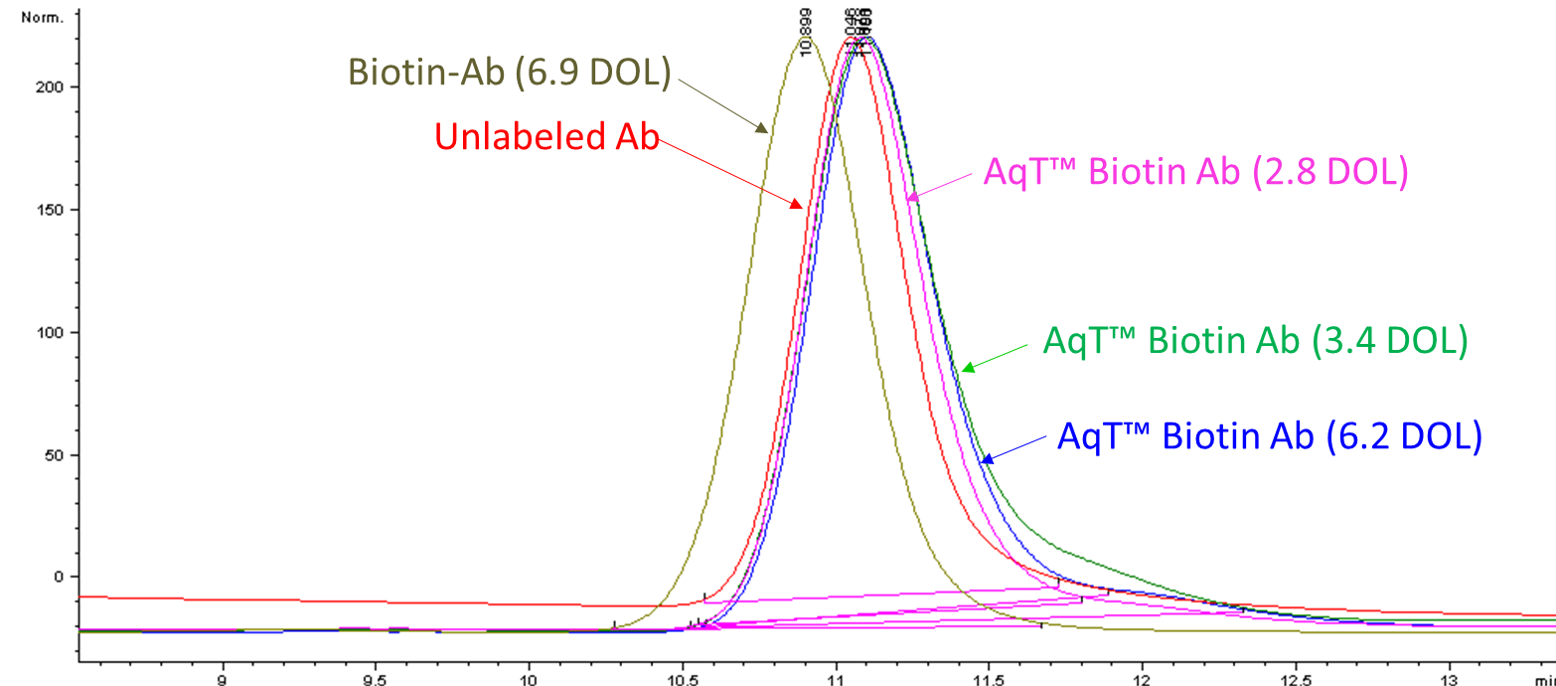AqueaTether® (AqT®) Technologies
Pioneering the Future of Bioconjugation with AqT® Technology
CellMosaic is advancing next-generation bioconjugation solution through its proprietary AqT® (Aqueous Technology) linkers — a revolutionary class of super-hydrophilic, high-loading biomaterials. These linkers are derived from natural, edible sugar alcohol compounds and engineered with unique chemical architectures to overcome the limitatioins of traditional conjugation chemistries.
AqT® linkers enable precise and efficient labeling or conjugation of biomolecules with highly hydrophobic small molecules— including fluorescent dyes, biotin, and small-molecule drugs — while maintaining biomolecular integrity and solubility. Moreover, branched AqT® linkers can be customized to load a higher number of detecting molecules, delivering significantly enhanced sensitivity and performance in analytical and diagnostic applications.
Beyond research tools, the AqT® platform is transforming therapeutic development. By improving solubility, stability, and biocompatibility, AqT® technology helps accelerate drug discovery and the creation of new chemical entities and biological entities (NCEs and NBEs) with optimized drug profiles. This versatile platform provides elegant solutions to long-standing challenges such as bioavailability, formulation stability, and toxicity in both small- and large-molecule drug development.
For more information on AqT® technologies in therapeutic applicaitoin, please visit www.aqttherapeutics.com
Structure of AqT® Linkers
Sugar molecules are among the most hydrophilic natural compounds because they can form extensive hydrogen bonds as both donors and acceptors. Sugar alcohols, or polyols, are hydrogenated carbohydrates in which the carbonyl group (aldehyde or ketone) is reduced to a hydroxyl (-OH) group. They occur naturally in many plant-derived foods, such as fruits and berries, and are commonly used as sweeteners or as building blocks for materials like hydrogels. CellMosaic has developed advanced methods to assemble highly sophisticated AqT® architectures from sugar alcohol monomers.

| 3- Carbon | 4- Carbon | 5-Carbon | 6-Carbon |
| Glycerol | Erythritol | Arabitol | Mannitol |
| Threitol | Xylitol | Sorbitol | |
| |
Ribitol | Galactitol | |
| Fucitol | |||
| Iditol | |||
 |
Table 1: Common sugar alcohols commonly used to make AqT® linkers.
Advantages of AqT® Linkers
AqT® linkers offer several advantages over traditional linkers and polydisperse carrier polymers:
1) Super-hydrophilicity: AqT® linkers are among the most hydrophilic molecules available, providing the exceptional solubility and enabling fine-tuned control of molecular properties after conjugation.

Figure 1. C18 HPLC analysis of AqT® linker and other commercial linkers.
2) Versatility in Crosslinking: AqT® linkers enables the desing of crosslinking reagents with a broad range of functional groups, making them some of the most versatile and tunable molecules available today.

Figure 2. C18 column HPLC analysis of monodisperse AqT® linkers with varying lengths.
3) Enhanced Water Solubility: AqT® linkers significantly improve the water solubility of hydrophobic compounds, allowing conjugation reactions to be carried out in fully aqueous buffers in most cases.
4) Biocompatible: The biopolymer's Properties remain unchanged after AqT®-mediated labeling and conjugation with small molecules (see example of AqT®-biotinylated antibody)
 |
Biopolymers, such as antibodies and proteins/peptides often aggregates and precipitate when labeled with hydrophobic small molecules. AqT® linkers are designed to modify these molecules, enhancing their hydrophilicity and water solubility. The hydroxy (-OH) groups in AqT® form extensive hydrogen bonds with surrounding water, creating a protective microenvironment that shields neighboring small molecules or crosslinking moieties from stacking or interacting with each other. As a result, biopolymers can be labeled with high levels of AqT®-modified molecules without altering their native properties. This AqT®-stabilized hydrogen-bond network also helps protect biopolymers from enzymatic degradation, preserving their biological activity.
|
|
Figure 3. Hydrophobic interaction chromatographic (HIC) analysis of antibody, biotin-antibody (DOL: 6.9), and AqT®-biotinylated antibodies with various loadings. |
AqT™ Biotin: Retain antibody properties
Biotin: Change antibody properties
|
|
|
Figure 5. Size exclusion chromatographic (SEC) analysis of antibody, biotin-antibody (DOL: 6.9), and AqT® biotinylated antibodies with various loadings. |
AqT™ Biotin: Retain antibody properties
Biotin: Change antibody properties
|
|
Patent and License Restrictions
AqT® technology is protected under WO2013/012961A2, US patent numbers 8907079B2, 9511150B2, US15/281,023, Chinese patent 201280034231.3, Australian patent 2012284055, Japan patent 2014-521744, and equivalent patents and patent applications in other countries, all in the name of CellMosaic, Inc.
We currently offer a limited selection of AqT® products for internal research and development use only.
The purchase of AqT® products grants a limited license for internal R&D purpose only, and not for any commercial use. Commercial use includes, but is not limited to:
1. The sale, lease, license or other transfer of the material or any material derived or produced from it.
2. The sale, lease, license or other grant of rights to use this material or any material derived or produced from it.
3. The use of this material to perform services for a fee for third parties, including contract research and drug screening.
For inquiries regarding commercial use of AqT® products, please contact us for more information.
To explore partnering or collaboration opportunities in the development of AqT® therapeutics, visit www.aqttherapeutics.com .


